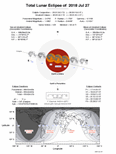![]()
- - text and links as of last publication - -
That second lunar eclipse for that year -- and the last lunar eclipse in 2018 -- is the total lunar eclipse of July 27th, 2018. A total lunar eclipse if a fine show worth the observation, with Moon progressively occulted and darkened by Earth's 'umbra,' giving a deep sense of the astronomical scales of the Universe and the large events which may occur there. for more about Moon eclipses, theoretically, see our tutorial: Moon Eclipses. The total lunar eclipse of July 27th is special in that it is a 'central' lunar eclipse, with the Moon's disk passing through the axis of Earth's umbra! That also brings that such a eclipse longs laster, at 103 minutes for that occurrence (which is a rare event!). All eclipses belonging to the Saros 129 that eclipse is belonging to, are taking place at Moon's descending node. The total lunar eclipse of July 27th, 2018 occurs 0.6 days after Moon's apogee -- which means a relatively smaller apparent diameter of the Moon -- and the eclipse will have like its starry background constellation Capricornus, the Goat
As the Moon during that total eclipse will transit really deep into the Earth's umbra, down to the axis of it, the eclipse, at greatest, will be remarkably dark. The entirety of the total eclipse will be seen from Turkey to India and from eastern and southern Africa to western Siberia. Areas either part of that either will have the eclipse by moonrise, like from western Russia down to most of South America, most of Europe and western Africa included, or the eclipse by moonset, like for most of the Far East, Indonesia, Australia, or New Zealand, and the western Pacific. No eclipse is see for the entire North America, central America, and the eastern Pacific
The eclipse's main data are the following (data as of November 2017, EclipseWise.com). for more about how to observe a lunar eclipse, see our tutorial 'Observing a Moon Eclipse':
- umbral magnitude (fraction of Moon's diameter immersed in the umbra at greatest): 1.60868
- greatest eclipse: 20:21:45.4 UT
- eclipse duration (penumbral): 06h13m54.7s
- eclipse duration (umbral): 03h54m34.2s
- eclipse duration (total): 01h42m57.3s
- eclipse contacts (in UT): P1 (penumbral eclipse begins) at 17:14:47.7, U1 (umbral eclipse begins) at 18:24:28.4, U2 (total eclipse begins) at 19:30:16.8, U3 (total eclipse ends) at 21:13:14.1, U4 (umbral eclipse ends) at 22:19:02.6, P4 (penumbral eclipse begins) at 23:28:42.4
 | see a .PDF map for the total lunar eclipse of July 27th, 2018 (path of the Moon within the Earth's umbra and map of the visibility of the eclipse worldwide). map courtesy EclipseWise.com |
. for more about this eclipse and for more about solar and lunar eclipses generally, you may see at the Internet, with Fred Espenak a reference in the domain
Website Manager: G. Guichard, site 'Amateur Astronomy,' http://stars5.6te.net. Page Editor: G. Guichard. last edited: 1/1/2019. contact us at geguicha@outlook.com